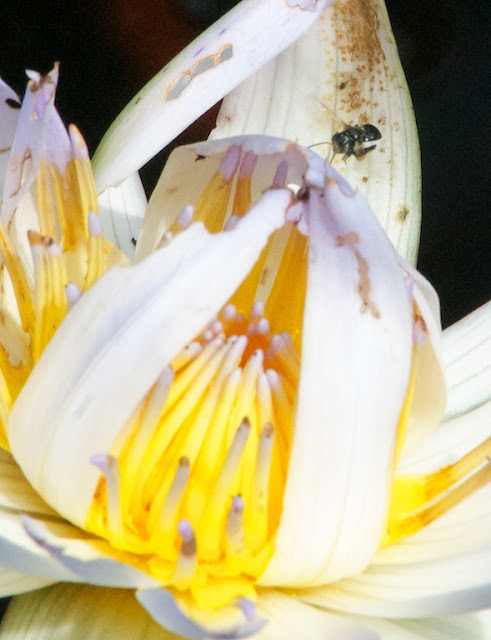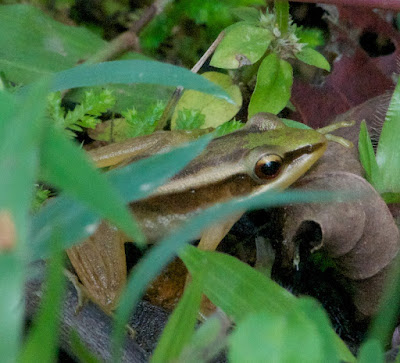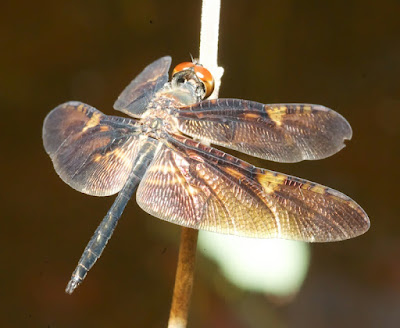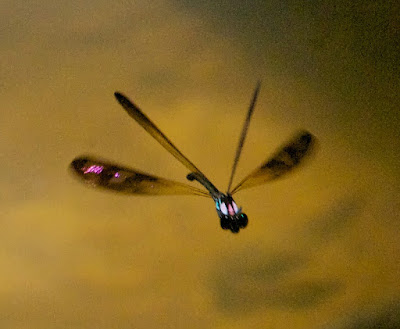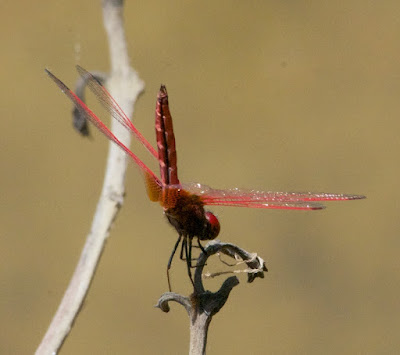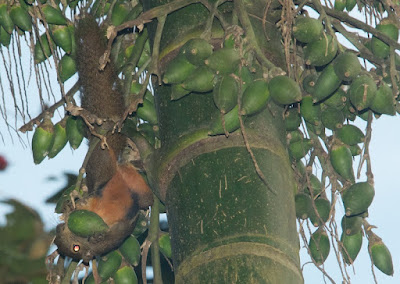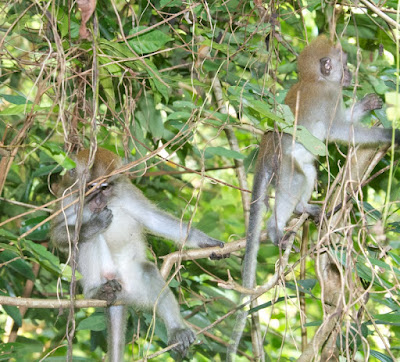On August 19, 2014, I stopped by for another look at one of my favourite dragonfly spots, the MJC forest in Batu Kawa. Despite being on the very edge of urban Kuching, it was still in excellent condition. I am sad to report, as I write this in July 2016, that this is no longer the case; the forest and the roadside ditches are still there, but the locals appear to have been using the area as a garbage dump - so unless a clean-up crew materializes soon, this and some ensuing writeups about MJC may be more in the nature of a eulogy.
Anyway, back in 2014 MJC was still a lovely spot.
Water lilies (Nymphaea sp) still bloomed in the permanent ditches along the road...
...and insects like this little stingless bee (Apidae; Apinae; Meliponini) still visited their flowers.
Golden Apple Snails (Pomacea canaliculata), introduced exotics from the Americas, flourished (and given their durability, probably still do).
Given their sensitivity to pollutants I am not so sure about the local frogs, though the Green Paddy Frog (Hylarana erythraea) apparently survives in heavily-sprayed rice paddies. It may still do so at MJC.
The Grey Pansy (Junonia atlites), a butterfly that seems to prefer open wet areas, was a common sight at MJC, and probably still is.
In 2014 I could expect, on an average visit, to find a dozen species of dragonfly and damselfly around and about the roadside ditches. I saw far fewer in 2016, but it will take more than one brief visit to find out if once-obvious species like Ictinogomphus decoratus have truly left the area. So I can't present a roll-call of missing species at this point (and I hope I won't have to at all).
Brachydiplax chalybea is one of the commonest dragonflies of vegetation-lined ditches, and is still apparently common at MJC.
Rhodothemis rufa (this is a female) was still there in 2016, but a number of others were nowhere in evidence - I hope to find them on a return trip.
Orchithemis pulcherrima (its specific name means "most beautiful") can be somewhat unobtrusive despire its bright colour, so though I failed to find it in 2016 it may still be there.
More surprising to me was the total absence, in 2016, of the genus Rhyothemis. Rhyothemis dragonflies are usually quite obvious, both because of their patterned wings and their distinctive behaviour (the members of the genus are commonly known as "flutterers".
Three species of this genus, including R. triangularis (not shown here) were among the commonest and most noticeable species in the area, and even on a quick visit I was surprised not to see at least one. In 2014 I could always find these strikingly-marked dragonflies at MJC. This is Rhyothemis obsolescens....
...and this is the largest of the three MJC species, Rhyothemis phyllis.
The spectacular damselfly Ceriagrion cerinorubellum is another of the survivors.
It is seemingly the only damselfly to thrive at MJC, but this is not, I suspect, because of the condition of the ditches. Cerinorubellum is a voracious carnivore, devouring every other damselfly in sight.
In fact the only other damselfly I have seen at MJC is an occasional, recently-emerged (teneral) Copera vittata. Like this one, the very few I have found kept out of the way, sheltering beneath tangles of brush.
This photograph, featuring Ceriagrion cerinorubellum, demonstrates the penalty for doing otherwise. I did not, in fact, realize what I was photographing until I zoomed in on my shot later on, when I realized that I had found another teneral Copera vittata that had apparently been pounced on, and was being devoured by, its larger, more colourful and dangerous cousin.
Saturday, July 16, 2016
Wednesday, July 13, 2016
Sarawak: Jousting Jewels
While our grandson Royce continued his treatment in Singapore, diligently attended by Eileen and, alternately, his Mom or Dad, his brothers Ryan and Ryder risked being overlooked back home in Kuching. We therefore decided that I would be more useful in Sarawak, where I could drive Ryan to and from school. Little Ryder, Royce's baby brother, was being well cared for by Eileen's sister Ye Guak (Ellen; the kids call her Mai Mai [Auntie]). Mai Mai's home is out of town, near Matang, and on August 18, 2014, she took me out there to explore the little stream next to her house.
In her garden I found an assortment of common insects - butterflies such as this Brown Pansy (Junonia hedonia)...
...and two of the three common local species of the ubiquitous genus Neurothemis, the smaller N. fluctuans...
...and the larger Neurothemis terminata (note the different shape of the clear area on the hindwing).
Clear, shaded streams in Sarawak, including Mai Mai's, are the province of the short-bodied damselflies of the family Chlorocyphidae, generally known as Jewels. One chlorocyphid that certainly deserves that name 'jewel' is the common Heliocypha biseriata, whose females (top) are mostly black and yellowish but whose males (below) boast iridescent patches of amethyst and blue on their bodies and wings. The wing patches flash like signal lights in flight - and that is precisely what the males use them for.
Heliocypha biseriata males are highly territorial, defending short stretches of stream along fallen logs where the females lay their eggs. When a rival appears on the scene, the two males challenge each other in aerial contests during which they fly up and down while facing each other, flashing the iridescent wing patches on the undersides of their wings.
These jousts rarely last more than a minute or so (unlike the contests of some other chlorocyphid males, which can go on for more than half an hour).
Here's video of the jousting jewels in action.
Mai Mai, noting my interest in damselflies, offered to take me to another potential site not far away - a gravelly river in the Jubilee Mas Park (Taman Rekreasi Jubilee Mas).
I found nothing new here, but did enjoy seeing this Prodasineura verticalis, one of Sarawak's most attractive damselflies.
Heliocypha biseriata was here too; this is a female.
Streams with lots of emergent stones seem very attractive to Trithemis aurora...
...a dragonfly that is certainly beautiful, but that seems to take the habit many dragonflies have of assuming the so-called obelisk posture to an extreme. This one seems about to topple over itself.Clear, shaded streams in Sarawak, including Mai Mai's, are the province of the short-bodied damselflies of the family Chlorocyphidae, generally known as Jewels. One chlorocyphid that certainly deserves that name 'jewel' is the common Heliocypha biseriata, whose females (top) are mostly black and yellowish but whose males (below) boast iridescent patches of amethyst and blue on their bodies and wings. The wing patches flash like signal lights in flight - and that is precisely what the males use them for.
Heliocypha biseriata males are highly territorial, defending short stretches of stream along fallen logs where the females lay their eggs. When a rival appears on the scene, the two males challenge each other in aerial contests during which they fly up and down while facing each other, flashing the iridescent wing patches on the undersides of their wings.
These jousts rarely last more than a minute or so (unlike the contests of some other chlorocyphid males, which can go on for more than half an hour).
Mai Mai, noting my interest in damselflies, offered to take me to another potential site not far away - a gravelly river in the Jubilee Mas Park (Taman Rekreasi Jubilee Mas).
I found nothing new here, but did enjoy seeing this Prodasineura verticalis, one of Sarawak's most attractive damselflies.
Heliocypha biseriata was here too; this is a female.
Streams with lots of emergent stones seem very attractive to Trithemis aurora...
Monday, July 11, 2016
Singapore: A Walk in the Central Catchment (Part 3)
The forests of Singapore's Central Catchment may not be home to much in the way of big game, but besides the collection of interesting plants and insects featured in my last two postings (covering a walk through the area on August 8, 2014), they boast an assortment of smaller, but equally interesting, vertebrates.
As in almost any tropical forest, there is a variety of lizards. We found at least two Kendall's Rock Geckos (Cnemaspis kendallii), a lizard of mature forests largely confined in Singapore to the Central Catchment and the Bukit Timah Reserve. It is supposed to prefer to cling to rocks and tree trunks; here are two individuals, one on each of the species' chosen substrates.
The Striped Sun Skink (Eutropis rugifera) is also confined to forest reserves in Singapore, where it is considered to be an endangered species. This one has escaped from some predator, shedding its tail in the process.
The most fascinating of Southeast Asia's arboreal reptiles are surely the gliding lizards, popularly known as flying dragons. We found several Black-bearded Gliding Lizards (Draco melanopogon) along the trail through the Central Catchment, mostly clinging to the trunks of trees, doing their best to pass themselves off as thin twigs.
Males, tough, are actually fairly striking at close range, with their orange throats and black dewlaps.
When they choose, they draw attention to themselves by repeatedly erecting the dewlap - a display that recalls the vaguely similar displays of Anolis lizards in the Americas.
Females lack the dewlap and coloured throat, but these photographs show the feature that makes Draco lizards truly unique. The folded finlike structure along the lizard's side is a sail, supported on extensions of the ribs. The sails, often brightly coloured (though not particularly so in this species), enable these lizards to launch into the air and glide up to 9 metres to their next perch.
As in almost any tropical forest, there is a variety of lizards. We found at least two Kendall's Rock Geckos (Cnemaspis kendallii), a lizard of mature forests largely confined in Singapore to the Central Catchment and the Bukit Timah Reserve. It is supposed to prefer to cling to rocks and tree trunks; here are two individuals, one on each of the species' chosen substrates.
The Striped Sun Skink (Eutropis rugifera) is also confined to forest reserves in Singapore, where it is considered to be an endangered species. This one has escaped from some predator, shedding its tail in the process.
The most fascinating of Southeast Asia's arboreal reptiles are surely the gliding lizards, popularly known as flying dragons. We found several Black-bearded Gliding Lizards (Draco melanopogon) along the trail through the Central Catchment, mostly clinging to the trunks of trees, doing their best to pass themselves off as thin twigs.
Males, tough, are actually fairly striking at close range, with their orange throats and black dewlaps.
When they choose, they draw attention to themselves by repeatedly erecting the dewlap - a display that recalls the vaguely similar displays of Anolis lizards in the Americas.
Females lack the dewlap and coloured throat, but these photographs show the feature that makes Draco lizards truly unique. The folded finlike structure along the lizard's side is a sail, supported on extensions of the ribs. The sails, often brightly coloured (though not particularly so in this species), enable these lizards to launch into the air and glide up to 9 metres to their next perch.
Midday is never the best time for birding, but I did have a chance to photograph this Greater Racket-tailed Drongo (Dicrurus paradiseus), sans rackets.
Singapore, like southern Florida, has its share of exotic parrots, but the Long-tailed Parakeet (Psttacula longicauda) is a native. It is a forest bird, one that may be being displaced in more settled areas by its introduced cousins such as the Red-breasted Parakeet (P. alexandri).
Mammal-watching, by day, is most likely to involve squirrels, and we found both of Singapore's surviving native diurnal species, the common Plantain Squirrel (Callosciurus notatus)...
...and the considerably smaller Slender Squirrel (Sundasciurus tenuis). Among other things, Slender Squirrels eat the soft bark of forest trees, as the animal in the lower picture appears to be doing.
Singapore has its own distinctive population of Long-tailed Macaque (Macaca fascicularis), differing in size and a few other features from those found in surrounding countries.
Snakes are shy creatures, and (like this one, much to the delight of the local flies) are more likely to be seen dead than alive.
However, we did come across a live snake at the end of our walk, a Spotted Keelback (Xenochrophis maculatus), a small species confined to the central forests. It appears to be non-venomous and, like most other snakes, it is not aggressive.
Snakes are frequently the victims of ticks (I have seen enormous ones on a boa constrictor in Costa Rica). This on was carrying a small brownish tick on the top of its head; compared to some victims, it appeared to be getting off lightly.
As we were leaving the reserve, a Crimson Sunbird (Aethopyga siparaja) appeared in a flowering shrub not far from the gate. The most colourful of Singapore's sunbirds, it made for a suitable encounter to end our walk - in October 2015, a little more than a year later, the Crimson Sunbird was declared Singapore's National Bird.
Singapore, like southern Florida, has its share of exotic parrots, but the Long-tailed Parakeet (Psttacula longicauda) is a native. It is a forest bird, one that may be being displaced in more settled areas by its introduced cousins such as the Red-breasted Parakeet (P. alexandri).
Mammal-watching, by day, is most likely to involve squirrels, and we found both of Singapore's surviving native diurnal species, the common Plantain Squirrel (Callosciurus notatus)...
...and the considerably smaller Slender Squirrel (Sundasciurus tenuis). Among other things, Slender Squirrels eat the soft bark of forest trees, as the animal in the lower picture appears to be doing.
Singapore has its own distinctive population of Long-tailed Macaque (Macaca fascicularis), differing in size and a few other features from those found in surrounding countries.
Snakes are shy creatures, and (like this one, much to the delight of the local flies) are more likely to be seen dead than alive.
However, we did come across a live snake at the end of our walk, a Spotted Keelback (Xenochrophis maculatus), a small species confined to the central forests. It appears to be non-venomous and, like most other snakes, it is not aggressive.
Snakes are frequently the victims of ticks (I have seen enormous ones on a boa constrictor in Costa Rica). This on was carrying a small brownish tick on the top of its head; compared to some victims, it appeared to be getting off lightly.
As we were leaving the reserve, a Crimson Sunbird (Aethopyga siparaja) appeared in a flowering shrub not far from the gate. The most colourful of Singapore's sunbirds, it made for a suitable encounter to end our walk - in October 2015, a little more than a year later, the Crimson Sunbird was declared Singapore's National Bird.
Labels:
Singapore
Location:
Central Water Catchment, Singapore
Subscribe to:
Posts (Atom)




